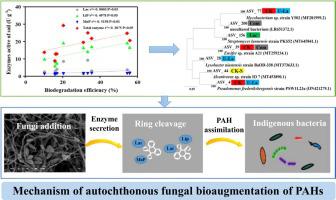Journal of Hazardous Materials ( IF 12.2 ) Pub Date : 2023-03-22 , DOI: 10.1016/j.jhazmat.2023.131271 Yeliang Dai 1 , Jibing Li 1 , Xiumin Yang 2 , Shuang Wang 1 , Xuan Zhao 1 , Yujie Wang 3 , Dayi Zhang 4 , Chunling Luo 1 , Gan Zhang 1

|
Autochthonous fungal bioaugmentation (AFB) is considered a reliable bioremediation approach for polycyclic aromatic hydrocarbon (PAH) contamination, but little is known about its mechanisms in contaminated soils. Here, a microcosm experiment was performed to explore the AFB mechanisms associated with two highly efficient phenanthrene degrading agents of fungi (with laccase-producing Scedosporium aurantiacum GIG-3 and non-laccase-producing Aspergillus fumigatus LJD-29), using stable-isotope-probing (SIP) and high-throughput sequencing. The results showed that each fungus markedly improved phenanthrene removal, and microcosms with both fungi exhibited the best phenanthrene removal performance among all microcosms. Additionally, AFB markedly shifted the composition of the microbial community, particularly the phenanthrene-degrading bacterial taxa. Interestingly, based on SIP results, strains GIG-3 and LJD-29 did not assimilate phenanthrene directly during AFB, but instead played key roles in the preliminary decomposition of phenanthrene though secretion of different extracellular enzymes to oxidize the benzene ring (GIG-3 bioaugmentation with laccase, and LJD-29 bioaugmentation with manganese and lignin peroxidases). In addition, all functional degraders directly involved in phenanthrene assimilation were indigenous bacteria, while native fungi rarely participated in the direct phenanthrene mineralization. Our findings provide a new mechanism of AFB with multiple fungi, and support AFB as a promising strategy for the in situ bioremediation of PAH-contaminated soil.
中文翻译:

通过稳定同位素探测对石油污染土壤中菲的原生真菌生物强化机制的新认识
原生真菌生物强化 (AFB) 被认为是一种可靠的多环芳烃 (PAH) 污染生物修复方法,但对其在受污染土壤中的机制知之甚少。在这里,进行了微观实验以探索与真菌的两种高效菲降解剂相关的 AFB 机制(产漆酶的Scedosporium aurantiacum GIG-3 和不产漆酶的烟曲霉LJD-29),使用稳定同位素探测 (SIP) 和高通量测序。结果表明,每种真菌都显着提高了菲的去除率,并且具有两种真菌的微观世界在所有微观世界中表现出最好的菲去除性能。此外,AFB 显着改变了微生物群落的组成,尤其是菲降解细菌类群。有趣的是,根据 SIP 结果,菌株 GIG-3 和 LJD-29 在 AFB 期间不直接同化菲,而是通过分泌不同的胞外酶氧化苯环在菲的初步分解中发挥关键作用(GIG-3 生物强化与漆酶,以及 LJD-29 与锰和木质素过氧化物酶的生物强化)。此外,所有直接参与菲同化的功能降解者都是本土细菌,而本土真菌很少参与菲的直接矿化。我们的研究结果提供了 AFB 与多种真菌的新机制,并支持 AFB 作为一种有前途的策略PAH污染土壤的原位生物修复。











































 京公网安备 11010802027423号
京公网安备 11010802027423号